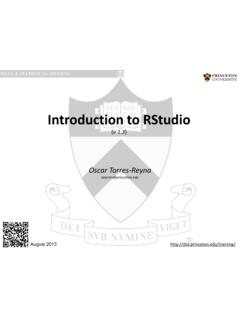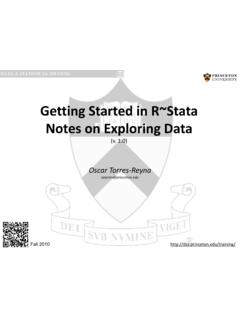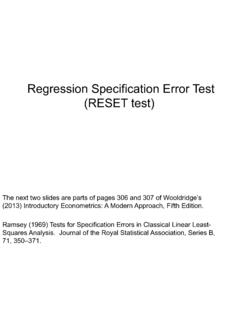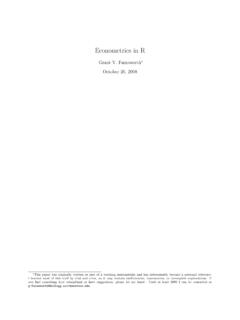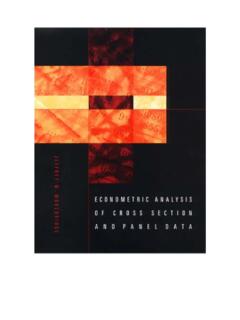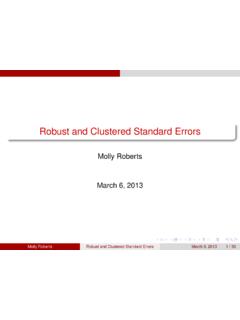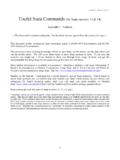Transcription of Linear Regression using Stata - Princeton University
1 Linear Regression using Stata ( ) Oscar Torres-Reyna December 2007 PU/DSS/OTRR egression: a practical approach (overview)We use Regression to estimate the unknown effectof changing one variable over another (Stock and Watson, 2003, ch. 4)When running a Regression we are making two assumptions, 1) there is a Linear relationship between two variables ( Xand Y) and 2) this relationship is additive ( Y= x1 + x2 + ..+xN). Technically, Linear Regression estimates how much Ychanges when Xchanges one unit. In Stata use the command regress, type:regress [dependent variable] [independent variable(s)]regress y xIn a multivariate setting we type:regress y x1 x2 x3.
2 Before running a Regression it is recommended to have a clear idea of what you are trying to estimate ( which are your outcome and predictor variables).A Regression makes sense only if there is a sound theory behind : a practical approach (setting)Example: Are SAT scores higher in states that spend more money on education controlling by other factors?* Outcome (Y) variable SAT scores, variable csatin dataset Predictor (X) variables Per pupil expenditures primary & secondary (expense) % HS graduates taking SAT (percent) Median household income (income) % adults with HS diploma (high) % adults with college degree (college) Region (region)*Source: Data and examples come from the book Statistics with Stata (updated for version 9)by Lawrence C.
3 Hamilton (chapter 6). Click here to download the data or search for it at Use the file (educational data for the ). 3PU/DSS/OTRR egression: variablesIt is recommended first to examine the variables in the model to check for possible errors, type:use csat expense percent income high college regionsummarize csat expense percent income high college region region byte % region Geographical regioncollege float % % adults college degreehigh float % % adults HS diplomaincome double % Median household income, $1.
4 000percent byte % % HS graduates taking SATexpense int % Per pupil expenditures prim&seccsat int % Mean composite SAT score variable name type format label variable label storage display value. describe csat expense percent income high college region region 50 1 4 college 51 high 51 income 51 percent 51 4 81 expense 51 2960 9259 csat 51 832 1093
5 Variable Obs Mean Std. Dev. Min Max. summarize csat expense percent income high college region4PU/DSS/OTRR egression: what to look forThis is the p-value of the model. It tests whether R2is different from 0. Usually we need a p-value lower than to show a statistically significant relationship between X and squareshows the amount of variance of Y explained by X. In this case expenseexplains 22% of the variance in SAT run the Regression :regress csat expense, robustAdj R2(not shown here) shows the same as R2but adjusted by the # of cases and # of variables.
6 When the # of variables is small and the # of cases is very large then Adj R2is closer to R2. This provides a more honest association between X and p-values test the hypothesis that each coefficient is different from 0. To reject this, the p-value has to be lower than (you could choose also an alpha of ). In this case, expense is statistically significant in explaining t-values test the hypothesis that the coefficient is different from 0. To reject this, you need a t-value greater than (for 95% confidence). You can get the t-values by dividing the coefficient by its standard error.
7 The t-values also show the importance of a variable in the = 1061 - *expenseFor each one-point increase in expense, SAT scores decrease by variable (Y)Predictor variable (X)123456 robust standard errors (to control for heteroskedasticity ) _cons expense .0036719 csat Coef. Std. Err. t P>|t| [95% Conf.]
8 Interval] robust Root MSE = R-squared = Prob > F = F( 1, 49) = Regression Number of obs = 51. regress csat expense, robustRoot MSE: root mean squared error, is the sd of the Regression .
9 The closer to zero better the fit. 75PU/DSS/OTRR egression: what to look forThis is the p-value of the model. It indicates the reliability of X to predict Y. Usually we need a p-value lower than to show a statistically significant relationship between X and squareshows the amount of variance of Y explained by X. In this case the model explains of the variance in SAT the rest of predictor variables:regress csat expense percent income high college, robustAdj R2(not shown here) shows the same as R2but adjusted by the # of cases and # of variables.
10 When the # of variables is small and the # of cases is very large then Adj R2is closer to R2. This provides a more honest association between X and p-values test the hypothesis that each coefficient is different from 0. To reject this, the p-value has to be lower than (you could choose also an alpha of ). In this case, expense, income, andcollegeare not statistically significant in explaining SAT; highis almost significant at Percentis the only variable that has some significant impact on SAT (its coefficient is different from 0)The t-values test the hypothesis that the coefficient is different from 0.
